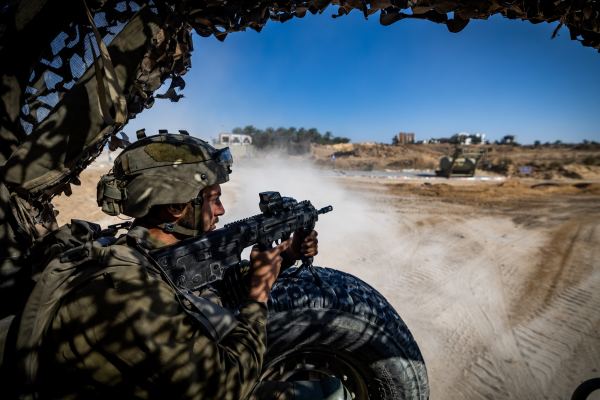The IDF has demonstrated that it can operate in the most challenging urban warfare environment in the world.
By Yaakov Lappin, JNS
On Feb. 15, the IDF announced formally that it had begun operating in Nasser Hospital in Khan Yunis, which like every other medical, educational and civilian site in Gaza served as a Hamas military hub.
As IDF special forces entered the complex, some 200 Hamas members surrendered without firing a shot.
The IDF began the operation with a call to the hospital’s director from Col. Moshe Tetro, head of the Gaza Coordination and Liaison Administration, who is responsible for the IDF’s humanitarian efforts throughout the war.
“In the past month, the IDF has asked the residents of Khan Yunis to evacuate to safer areas, in the humanitarian areas of Al-Mawasi [in southern Gaza] and Deir al-Balah [in central Gaza]. We have information that proves that the Hamas terrorist organization is continuing its military activity in the Nasser hospital compound, and that the compound was used to hold Israeli hostages,” Tetro told the director.
Tetro called on Hamas to exit the site, as well as for thousands of Gazan civilians who had set up camp in and around the hospital to leave.
Speaking to journalists last week, Tetro said the Nasser operation was “inevitable, since Hamas repeatedly and systematically uses hospitals for their terrorist activities.”
Out of an estimated 10,500 Gazan civilians in the compound, the IDF evacuated around 8,000 before forces entered, Tetro assessed.
Once Israeli forces entered the hospital, he said, the IDF continued to work with medical staff to protect patients and move them out of combat zones. A “large amount” of water and food, including baby food, was also delivered by the IDF to those remaining in the facility, he said.
The IDF was in “close touch” with hospital staff regarding medical supplies, “and it is our understanding that there is no shortage of medical supplies at the moment,” he said.
During the operation, the hospital also received a generator from the IDF to ensure continued power supply to the Intensive Care Unit.
On Saturday, Feb. 23, a fault unrelated to the IDF operations was discovered in the hospital’s electrical infrastructure, and the IDF has brought in technicians to address it, said Tetro.
“Finally, in the days since the operation we have coordinated several convoys of ambulances and assisted in transferring patients…to more suitable places to receive treatments,” he said.
The IDF’s raid on Nasser hospital would have likely been considered impossible by many observers prior to the launch of Israel’s ground operation in Gaza on Oct. 27.
Yet today, it has become the norm, and with roughly three-quarters of Gaza under IDF control, the military has demonstrated that despite predictions of doom, it can operate in the most challenging urban warfare environment in the world.
With more than 10,000 Hamas terrorists killed and several thousand more injured, and growing numbers of key Hamas tunnels taken out of commission (the military does not seek to destroy every tunnel under Gaza), the IDF has removed roughly half of Hamas’s terror army from the battlefield, including tens of Hamas battalion and company commanders.
The IDF is gradually moving into the more targeted mopping-up phase in the north and central Gaza. While there will always be terrorists in Gaza, the IDF is steadily achieving Israel’s war aim of shattering Hamas as an organized terror army and subsequently, as a political regime.
Despite the vast complexities of waging war in the Strip, the IDF has demonstrated that it has developed the tools to make consistent progress, while ensuring humanitarian supply lines and fully observing international laws of war.
Addressing the issue of humanitarian aid trucks entering Gaza, Tetro said that on the Palestinian side of the Kerem Shalom Crossing, there are “more than 450 trucks waiting for the international organizations to take the goods and to distribute them inside Gaza. We are ready and willing to facilitate the entrance of tens, if not hundreds of trucks every day.”
He added, “Unfortunately, today and yesterday, the United Nations didn’t show up to work. So as you probably have heard me say before, the bottleneck is not the Israeli side.”
